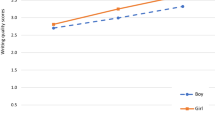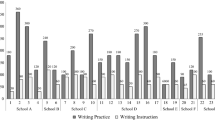Abstract
To examine the importance of manual character writing to reading in a new writing system, 48 adult Chinese-as-a-foreign-language students were taught characters in either a character writing-to-read or an alphabet typing-to-read condition, and engaged in corresponding handwriting or typing training for five consecutive days. Prior knowledge of orthography and phonology was assessed before training. At the end of each training day, improved orthographic quality was assessed via increased skill in producing Chinese characters at both the component and global levels. In addition, pretests and posttests were administered at each training day, and the proportional changes were used as the measure of learning gains. Outcomes replicated earlier findings of improved phonological knowledge following pinyin-typing practice and improved semantic knowledge following handwriting practice. Improvement in handwriting quality played a significant role in predicting reading gains after controlling for prior knowledge.



Similar content being viewed by others
References
Berninger, V. W., Abbott, R. D., Abbott, S. P., Graham, S., & Richards, T. (2002). Writing and reading: Connections between language by hand and language by eye. Journal of Learning Disabilities, 35, 39–56. doi:10.1177/002221940203500104.
Brashers-Krug, T., Shadmehr, R., & Bizzi, E. (1996). Consolidation in human motor memory. Nature, 382, 252–255. doi:10.1038/382252a0.
Cao, F., Rickles, B., Vu, M., Zhu, Z., Chan, D. H. L., Harris, L. N., et al. (2013a). Early stage visual-orthographic processes predict long-term retention of word form and meaning: A visual encoding training study. Journal of Neurolinguistics, 26(4), 440–461.
Cao, F., Vu, M., Chan, H., Lawrence, J., Harris, L., Guan, C. Q., et al. (2013b). Writing affects the brain network of reading in Chinese: An fMRI study. Human Brain Mapping,. doi:10.1002/hbm.22017.
Chan, D. W., Ho, C. S.-H., Tsang, S.-M., Lee, S.-H., & Chung, K. K. H. (2006). Exploring the reading–writing connection in Chinese children with dyslexia in Hong Kong. Reading and Writing, 19, 543–561. doi:10.1007/s11145-006-9008-z.
Chang, L. Y., Xu, Y., Perfetti, C. A., Zhang, J., & Chen, H. C. (2014). Supporting orthographic learning at the beginning stage of learning to read Chinese as a second language. International Journal of Disability Development and Education, 61(3), 288–305.
Chen, S. N., & Shen, M. M. (2004). 40 Lessons for basic Chinese course. Shanghai: East China Normal University Press.
Ehri, L. (2005). Learning to read words: Theory, findings, and issues. Scientific Studies of Reading, 9(2), 167–188.
Ehri, L. (2014). Orthographic mapping in the acquisition of sight word reading, spelling memory, and vocabulary learning. Scientific Studies of Reading, 18(1), 5–21.
Ellis, R. (1997). Second language acquisition. New York: Oxford University Press.
Fei, J. C., Huang, Y. Y., & Zhang, J. X. (Eds.). (1992). A dictionary for Chinese characters handwriting standardization. Shanghai: Shanghai Dictionaries Press.
Feldman, L. B., & Siok, W. W. T. (1997). The role of component function in visual recognition of Chinese characters. Journal of Experimental Psychology. Learning, Memory, and Cognition, 23, 776–781.
Feldman, L. B., & Siok, W. W. T. (1999). Semantic radicals contribute to the visual identification of Chinese characters. Journal of Memory and Language, 40, 559–576.
Fitzgerald, J., & Shanahan, T. (2000). Reading and writing relations and their development. Educational Psychologist, 35, 39–50. doi:10.1207/S15326985EP3501_5.
Flores d’Arcais, G. B. (1994). Order of strokes writing as a cue for retrieval in reading Chinese characters. European Journal of Cognitive Psychology, 6, 337–355. doi:10.1080/09541449408406519.
Foraker, S., & McElree, B. (2011). Comprehension of linguistic dependencies: Speed-accuracy tradeoff evidence for direct-access retrieval from memory. Language and Linguistics Compass, 5(1), 764–783.
Graham, S. (2006). Writing. In P. A. Alexander & P. H. Winne (Eds.), Handbook of educational psychology (2nd ed., pp. 457–478). Mahwah, NJ: Erlbaum.
Graham, S., & Hebert, M. (2011). Writing to read: A meta-analysis of the impact of writing and writing instruction on reading. Harvard Educational Review, 81, 710–744.
Guan, C. Q., Liu, Y., Chan, D. H. L., & Perfetti, C. A. (2011). Writing strengthens orthography and alphabetic-coding strengthens phonology in learning to read Chinese. Journal of Educational Psychology, 103(3), 509–522.
Guan, C. Q., Ye, F., Meng, W. J., & Leong, C. K. (2013). Are poor Chinese text comprehenders also poor in written composition. Annals of Dyslexia, 63, 217–238. doi:10.1007/s11881-013-0081-0.
Guan, C. Q., Ye, F., Wagner, R. K., Leong, C. K., & Meng, W.-J. (2014). Reading mediates the roles of morphological awareness, syntactic processing, and working memory in accounting for individual differences in Chinese written composition. Journal of Educational Psychology,. doi:10.1037/a0035984.
Guan, C. Q., Ye, F., Wagner, R. K., & Meng, W. J. (2012). Developmental and individual differences in Chinese writing. Reading and Writing: An International Journal, 26, 1031–1056. doi:10.1007/s11145-012-9405-4.
Han, Z., Song, L., & Bi, Y. (2011). Cognitive mechanism of writing-to-dictation of logographic characters. Applied Psycholinguistics, 33(3), 1–21.
Ho, C. S. H., Ng, T.-T., & Ng, W.-K. (2003). A “radical” approach to reading development in Chinese: The role of semantic radicals and phonetic radicals. Journal of Literacy Research, 35(3), 849–878.
James, K. H. (2010). Sensori-motor experience leads to changes in visual processing in the developing brain. Developmental Science, 13, 279–288.
James, K. H., & Atwood, T. P. (2009). The role of sensorimotor learning in the perception of letter-like forms: Tracking the causes of neural specialization for letters. Cognitive Neuropsychology, 26, 91–110.
James, K. H., & Gauthier, I. (2009). When writing impairs reading: Letter perception’s susceptibility to motor interference. Journal of Experimental Psychology: General, 138, 416–431.
Krashen, S. D. (1981). Second language acquisition and second language learning. New York: Longman Press.
Kučera, H., & Francis, W. (1967). Computational analysis of present-day American English. Providence, RI: Brown University Press.
Leong, C. K., Loh, K. Y., Ki, W. W., & Tse, S. K. (2011). Enhancing orthographic knowledge helps spelling production in eight-year-old Chinese children at risk for dyslexia. Annals of Dyslexia, 61, 136–160.
Lin, D., McBride-Chang, C., Shu, H., Zhang, Y., Li, H., Zhang, J., et al. (2010). Small wins big: Analytic Pinyin skills promote Chinese word reading. Psychological Science, 21, 1117–1122. doi:10.1177/0956797610375447.
Liu, Y., Wang, M., & Perfetti, C. A. (2007). Threshold-style processing of Chinese characters for adult second-language learners. Memory and Cognition, 35(3), 471–480.
Longcamp, M., Boucard, C., Gilhodes, J.-C., Anton, J.-L., Roth, M., Nazarian, B., & Velay, J.-L. (2008). Learning through hand- or typewriting influence visual recognition of new graphic shapes: Behavioral and functional imaging evidence. Journal of Cognitive Neuroscience, 20, 802–815. doi:10.1162/jocn.2008.20504.
Longcamp, M., Zerbato-Poudou, M. T., & Velay, J. L. (2005). The influence of writing practice on letter recognition in preschool children: A comparison between handwriting and typing. Acta Psychologica, 119, 67–79. doi:10.1016/j.actpsy.2004.10.019.
McBride-Chang, C., Lam, F., Lam, C., Chan, B., et al. (2011). Early predictors of dyslexia in Chinese children: Familial history of dyslexia, language delay, and cognitive profiles. Journal of Child Psychology and Psychiatry and Allied Disciplines, 52(2), 204–211.
Nakamura, K., Kuo, K. J., Pegado, F., Cohen, L., Tzeng, O. J. L., & Dehaene, S. (2012). Universal brain systems for recognizing word shapes and handwriting gestures during reading. Proceedings of the National Academy of Sciences USA, 109, 20762–20767.
Parkinson, J., Dyson, B. J., & Khurana, B. (2010). Line by line: The ERP correlates of stroke order priming in letters. Experimental Brain Research, 201, 575–586.
Perfetti, C. A. (2007). Reading ability: Lexical quality to comprehension. Scientific Studies of Reading, 11, 357–383.
Perfetti, C. A., Liu, Y., & Tan, L. H. (2005). The lexical constituency model: Some implications of research on Chinese for general theories of reading. Psychological Review, 112, 43–59. doi:10.1037/0033-295X.112.1.43.
Qiu, X. (2000). Chinese writing (G. L. Mattos & J. Norman, Trans.). Berkeley: Society for the Study of Early China and The Institute of East Asian Studies, University of California.
Qu, Q. Q., Damian, M. F., Zhang, Q. F., & Zhu, X. B. (2011). Phonology contributes to writing: Evidence from written word production in a nonalphabetic script. Psychological Science, 22, 1107–1112.
Shadmehr, R., & Brashers-Krug, T. (1997). Functional stages in the formation of human long-term motor memory. The Journal of Neuroscience, 17, 409–419.
Shadmehr, R., & Holcomb, H. H. (1997). Neural correlates of motor memory consolidation. Science, 277, 821–825. doi:10.1126/science.277.5327.821.
Shanahan, T. (2006). Relations among oral language, reading, and writing development. In C. A. MacArthur, S. Graham, & J. Fitzgerald (Eds.), Handbook of writing research (pp. 171–183). New York, NY: Guilford Press.
Shanahan, T., & Lomax, R. C. (1986). An analysis and comparison of theoretical models of reading–writing relationship. Journal of Educational Psychology, 78, 116–123. doi:10.1037/0022-0663.78.2.116.
Siok, W. T., Niu, Z., Jin, Z., Perfetti, C. A., & Tan, L. H. (2008). A structural–functional basis for dyslexia in the cortex of Chinese readers. Proceedings of the National Academy of Sciences USA, 105, 5561–5566.
Taft, M., Zhu, X., & Peng, D. (1999). Positional specificity of radicals in Chinese character recognition. Journal of Memory and Language, 40, 498–519. doi:10.1006/jmla.1998.2625.
Tan, L. H., Spinks, J. A., Eden, G., Perfetti, C. A., & Siok, W. T. (2005). Reading depends on writing, in Chinese. Proceedings of the National Academy of Sciences USA, 102, 8781–8785. doi:10.1073/pnas.0503523102.
Verhoeven, L. (2013). Components of lexical quality: Process, development and intervention. Proceedings at Society for Scientific Studies of Reading, Hong Kong.
Wang, M., Perfetti, C. A., & Liu, Y. (2005). Chinese–English biliteracy acquisition: Cross-language and writing system transfer. Cognition, 97, 67–88.
Wang, S. F., & Xu, G. R. (1993). Practical knowledge of Chinese characters. Beijing: Beijing Yanshan Press.
Wen, Y. Z. (1964). Strokes and stroke sequences of Chinese characters. Shanghai: Shanghai Educational Press.
Wu, X., Li, W., & Anderson, R. C. (1999). Reading instruction in China. Journal of Curriculum Studies, 31, 571.
Zhu, X., & Taft, M. (1994). Complexity effects in Chinese character processing. Paper presented to the Asian–Australian workshop on cognitive processing of Asian Languages.
Acknowledgments
This research was supported in part by China’s Young Talent Plan Fundamental Research Funds for the Central Universities (Nos. frf-br-B and frf-br-14-028A) to Connie Qun Guan, and by NIH Grant (1R01 HD058566 01A1) and National Science Foundation Grant (SBE-0836012) to the University of Pittsburgh.
Author information
Authors and Affiliations
Corresponding authors
Rights and permissions
About this article
Cite this article
Guan, C.Q., Perfetti, C.A. & Meng, W. Writing quality predicts Chinese learning. Read Writ 28, 763–795 (2015). https://doi.org/10.1007/s11145-015-9549-0
Published:
Issue Date:
DOI: https://doi.org/10.1007/s11145-015-9549-0




